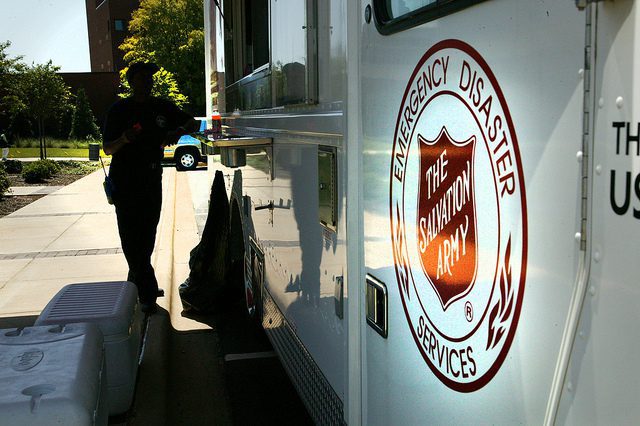Listen to this article
Listen to this article
Loading
Play
Pause
Options
0:00
-:--
1x
Playback Speed- 0.5
- 0.6
- 0.7
- 0.8
- 0.9
- 1
- 1.1
- 1.2
- 1.3
- 1.5
- 2
Audio Language
- English
- French
- German
- Italian
- Spanish
Open text
railton place supports at-risk youth. army officer visits sacramento on behalf of aged-out foster youth. by laine hendricks –. groups involved in social welfare issues in california are keeping a close eye on the state’s budget situation. on that watch list is the salvation army’s railton place, which provides 27 beds for “aged-out” foster youth in san francisco who otherwise would have nowhere to go when they reach 18 years of age. aging out of foster care usually results in unemployment, low rates of educational attainment and high rates of involvement with the criminal justice system. one study showed that only 10.8 percent of aged-out youth complete high school, less than half the rate for their peers of the same age and race. former foster youth were also 2.8 times more likely to be arrested and 70 percent more likely to be incarcerated. transitional housing placement plus (thp-plus)—a california state program—changes this picture drastically. a recent survey of youth in thp-plus programs found a 19 percent gain in employment, a 13 percent increase in hourly wage, and similar advances in education, health and housing stability. they also reported a 39 percent decrease in those who are “disconnected”—an individual who is neither employed nor attending school. budget cuts threaten program in his 2010-2011 budget proposal, governor arnold schwarzenegger suggested complete elimination of the thp-plus program. administrators of aged-out foster youth programs and other child welfare groups were outraged, including railton place program administrator captain lisa smith. “when we heard the thp-plus program was possibly going to be cut, i knew a plan of action needed to be in place,” smith said. “if it weren’t for this program, these young people would be more likely to end up on drugs, in prison, victims of domestic violence or as unwed parents.”. on two occasions this spring, representatives of youth welfare programs around california gathered at the state capitol to testify before legislators and share success stories of aged-out foster youth programs—specifically those funded by thp-plus—in teaching participants self-sufficiency, financial responsibility, enabling them to continue their education and—being vocational training—ultimately becoming productive citizens in society. “it’s great to be a part of a grassroots group that spoke to the powers that be and was heard,” smith said. “individuals can make a difference. advocacy works!”. through the efforts of many, both the senate and assembly budget subcommittees voted to restore full or partial funding to the program. though a positive step in saving thp-plus, the program still awaits its fate with the release of the budget revision in may. a proposed $80 million cut to child welfare services still lingers, which–if adopted—would significantly reduce the available funding for thp-plus programs.
Open context player
Close context player
Plays:-Audio plays count
railton place supports at-risk youth. army officer visits sacramento on behalf of aged-out foster youth. by laine hendricks –. groups involved in social welfare issues in california are keeping a close eye on the state’s budget situation. on that watch list is the salvation army’s railton place, which provides 27 beds for “aged-out” foster youth in san francisco who otherwise would have nowhere to go when they reach 18 years of age. aging out of foster care usually results in unemployment, low rates of educational attainment and high rates of involvement with the criminal justice system. one study showed that only 10.8 percent of aged-out youth complete high school, less than half the rate for their peers of the same age and race. former foster youth were also 2.8 times more likely to be arrested and 70 percent more likely to be incarcerated. transitional housing placement plus (thp-plus)—a california state program—changes this picture drastically. a recent survey of youth in thp-plus programs found a 19 percent gain in employment, a 13 percent increase in hourly wage, and similar advances in education, health and housing stability. they also reported a 39 percent decrease in those who are “disconnected”—an individual who is neither employed nor attending school. budget cuts threaten program in his 2010-2011 budget proposal, governor arnold schwarzenegger suggested complete elimination of the thp-plus program. administrators of aged-out foster youth programs and other child welfare groups were outraged, including railton place program administrator captain lisa smith. “when we heard the thp-plus program was possibly going to be cut, i knew a plan of action needed to be in place,” smith said. “if it weren’t for this program, these young people would be more likely to end up on drugs, in prison, victims of domestic violence or as unwed parents.”. on two occasions this spring, representatives of youth welfare programs around california gathered at the state capitol to testify before legislators and share success stories of aged-out foster youth programs—specifically those funded by thp-plus—in teaching participants self-sufficiency, financial responsibility, enabling them to continue their education and—being vocational training—ultimately becoming productive citizens in society. “it’s great to be a part of a grassroots group that spoke to the powers that be and was heard,” smith said. “individuals can make a difference. advocacy works!”. through the efforts of many, both the senate and assembly budget subcommittees voted to restore full or partial funding to the program. though a positive step in saving thp-plus, the program still awaits its fate with the release of the budget revision in may. a proposed $80 million cut to child welfare services still lingers, which–if adopted—would significantly reduce the available funding for thp-plus programs.
Listen to this article












